 |
The Saint of the Day
St. Laurence (or Lawrence), August 10
Prof. Plinio Corrêa de Oliveira
Biographical selection:
St. Laurence was chief of the seven Roman deacons of Pope Sixtus II. In 258 Emperor Valerian increased his persecutions of the Christians. One day when Pope Sixtus II was in the cemetery of St. Calistus celebrating the Holy Mysteries accompanied by some members of his clergy, he was arrested.
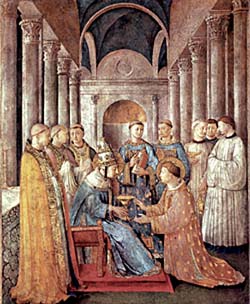
St. Sixtus II giving the order of deacon to St. Laurence, by Fra Angelico
|
As the soldiers took the Pontiff to be put to death, Laurence followed him in anguish saying: “Where are you going, my father, without your son? Where are you going, Holy Pontiff, without your deacon? Isn’t it the custom to offer the sacrifice with an assistant? Let me prove I am worthy of the choice you made when you entrusted me with the distribution of the Blood of Our Lord.”
Sixtus replied: “I am not leaving you, my son. They are lenient on old men, not the youth. A greater combat is reserved for you. You will follow me in three days.”
Thinking that the Christians had hidden great treasures, the prefect of Rome called for Laurence, who as first deacon was the custodian of the Church’s goods. The prefect ordered Laurence to hand over all the Church’s treasures. Laurence answered that he would do so but first he needed to assemble them. So he went out and gathered all the poor and sick people of Rome, then returned and showed them to the prefect, telling him that these were the sole and greatest treasure of the Church. The poor people were the gold, the virgins and widows were the pearls and other precious stones. Furious, the prefect condemned Laurence to die a slow and cruel death.
The saint was undressed and laid on a grill with burning coals beneath it. Witnesses of the scene saw a radiant joy on the martyr’s face. After a certain time had passed, he addressed his torturers saying: “Turn me around, because this side is already well cooked.” They turned him, and after a time he said: “It is done and ready to eat.” Then turning his eyes to Heaven he prayed to God for the conversion of Rome and expired. His body was carried away by converted Roman Senators who buried him in a grotto in the Verano field, near Tivoli.
Comments of Prof. Plinio:
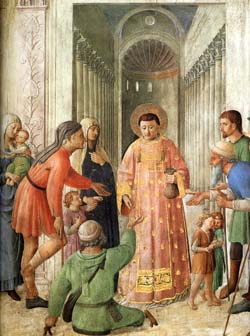
St. Laurence distributing alms to the poor,
by Fra Angelico
|
There are numerous precious data in this selection.
The first is the dialogue between St. Laurence and St. Sixtus. You know that the holy Sacrifice of the Mass is the bloodless reenacting of the holy sacrifice of the Cross. Now, when a martyr offers his holocaust he imitates Our Lord Jesus Christ who immolated Himself. It is not the reenactment of the sacrifice of the Mass, but it is analogous to it.
Therefore, one finds two correlations with the Sacrifice of Calvary in the admirable dialogue between St. Sixtus and his Deacon. St. Laurence said to the Pontiff: “Often have you offered the Holy Sacrifice of the Mass with me as assistant. Now at the moment you go to offer you life, would you have no more need of my assistance? Are you putting me aside at this moment? Don’t you want my help? Let me go with you to be killed with you. Since I have served you at the foot of the altar during my life, let me serve you now at the feet of death.”
After hearing this marvelous proposal, St. Sixtus prophesized: “I will have an easy death compared to yours. You, young man, will be spared much less than the old man I am. In three days you also will be killed.”
Second, the fidelity of St. Laurence to St. Sixtus shows us a first spark of the Middle Ages. Theirs was a relationship that was primordially ecclesiastic, but it was already a feudal fidelity. This union between lord and vassel in which the person who serves unites himself to the one he serves is much more than a work contract; it is a link of veneration and dedication, it is to offer one’s life. The person who serves realizes that he loses his reason to exist without his superior. In this splendid bond of fidelity of St. Laurence to St. Sixtus, we see a beginning of feudalism. In his turn, the superior esteems and protects the inferior. This kind of relationship represented one of the glories of the Middle Ages. Its remnants survived in Christendom even after the French Revolution. In its depth, what the Progressivist Church does is struggle to extinguish the last vestiges of this.
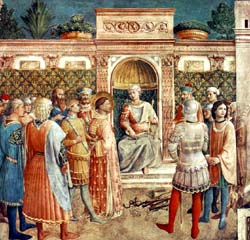
St. Laurence before the prefect,
by Fra Angelico
|
Third, another admirable point to consider is the episode with the prefect. St. Laurence brought him all the treasures of the Church: the poor people. You have to consider that for the pagan mentality, the poor were despicable. The Romans of that time had an extreme repulsion for the poor. But St. Laurence presented the poor to the prefect as the Church’s treasure. He gave the prefect an extraordinary lesson of the supernatural spirit.
Why are the poor a treasure?
There are some titles that make any baptized Catholic a treasure: he is a man who is a son of the Catholic Church; he was saved by the infinitely precious Blood of Our Lord Jesus Christ; he was worthy of the supremely valuable tears of Our Lady in the Passion.
But, there are other titles that specifically apply to the condition of one who is poor. God loves those who suffer deprivation with resignation and in union with Him. When poverty is involuntary, it should be loved by both the one who is poor and by the one who is not. The latter should help the former to leave the state of poverty, but both should realize that there is a real merit in accepting such poverty with resignation. The same applies to sickness. The Church does more than anyone to alleviate illnesses, but she also loves the sick and praises the afflicted man when he bears the suffering with resignation to the will of God. Therefore, one can say that the poor, like the widow and orphan, are a treasure. They are truly treasures within the Holy Church. St. Laurence gave an admirable lesson of the supernatural spirit to the prefect of Rome.
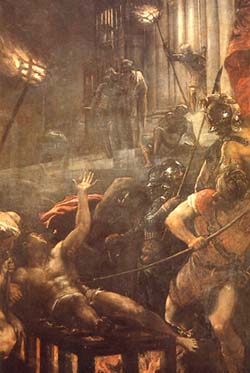
The martyrdom of St. Laurence, by Titian
|
Fourth, the last lesson St. Laurence gave us was his martyrdom. Without a miracle – and a first class miracle – one cannot understand how a man suffered what he did. He was slowly roasted on a grill with live coals beneath it. You can imagine how painful this would be. Consider how a live animal put to such torment would react: it would roar and jump trying to escape the pain. In a man this torture would raise even stronger reactions, because the animal doesn’t have intelligence and can’t understand what is happening. Understanding makes the suffering still greater.
St. Laurence, however, was extremely tranquil before such suffering, with his face radiating joy. When he realized that a part of his body was dead, he asked to be turned over to the other side. He was turned, and then he died. You can see that there were successive miracles that permitted him to remain calm and joyful, and then to live longer even after he was entirely roasted on one side. When his hour finally came, he asked for the conversion of Rome. And God heard his prayer at that very moment he expired, for several Roman Senators who were assisting at his martyrdom converted and carried his body to the grave. That is, he, a simple deacon, poor himself and living in the catacombs, had his body carried by members of the highest legislative and political organ on earth at that time, the Roman Senate.
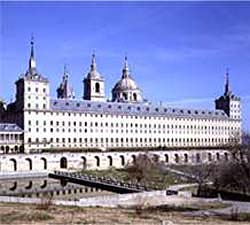
The official name of this palace is Monastery of St. Laurence of the Escorial. It was designed in the shape of a grill, which can be seen from an aerial view, not shown
|
In the Magnificat Our Lady entoned this rule: Deposuit potentes de sede et exaltavit humiles – God puts down the mighty from their seats and exalts the humble. Today no one knows the name of the prefect of Rome, almost no one knows anything about the Emperor Valerian. Regarding the latter, people either forgot him or consider him with horror. On the contrary, a great many people know about the humble St. Laurence and love him. One of the most famous palaces of the world, the Escorial, was built in Spain by the great King Philip II in honor of St. Laurence.
Philip II had a difficult time fighting the French Protestants. On the feast day of St. Laurence in the place called St. Quentin he engaged in a hard and decisive battle against the Protestants. He made God a promise to build a magnificent basilica in honor of St. Laurence if he won the battle. He crushed the heretics, and to commemorate the occasion he erected the greatest work of art of his reign, the Escorial. This palace was built in the shape of a grill to celebrate the martyrdom of St. Laurence. In this way Philip II perpetuated the glory of St. Laurence. This is just one example. The Catholic Church has honored him in many other ways, celebrating his virtues and venerating him.
You have, then, a realization of what Our Lady entoned: the powerful were put down and erased from the memory of the people and the humble were glorified.
Let us ask St. Laurence to give us that same supernatural spirit he displayed before the prefect, and his panache in face of his sufferings and death.


  | | Prof. Plinio Corrêa de Oliveira | |
The Saint of the Day features highlights from the lives of saints based on comments made by the late Prof. Plinio Corrêa de Oliveira. Following the example of St. John Bosco who used to make similar talks for the boys of his College, each evening it was Prof. Plinio’s custom to make a short commentary on the lives of the next day’s saint in a meeting for youth in order to encourage them in the practice of virtue and love for the Catholic Church. TIA thought that its readers could profit from these valuable commentaries.
The texts of both the biographical data and the comments come from personal notes taken by Atila S. Guimarães from 1964 to 1995. Given the fact that the source is a personal notebook, it is possible that at times the biographic notes transcribed here will not rigorously follow the original text read by Prof. Plinio. The commentaries have also been adapted and translated for TIA’s site.
|
Saint of the Day | Home | Books | CDs | Search | Contact Us | Donate

© 2002- Tradition in Action, Inc. All Rights Reserved
|
 |

|